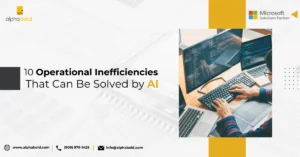Table of Contents
Introduction
This blog highlights the benefits of AI-powered predictive maintenance, including cost savings, higher equipment reliability, and improved operational efficiency, with real-world manufacturing examples and adoption insights.
Unexpected equipment failures can halt production, costing up to $260,000 per hour of downtime. Traditional reactive and preventive maintenance often falls short; reactive fixes are only applied after failures occur, and preventive schedules may not reflect actual equipment conditions.
AI-driven predictive maintenance uses sensor data, historical logs, and operational records to detect early warning signs. Machine learning techniques like anomaly detection and time-series analysis help predict failures accurately, minimize unplanned downtime, and optimize maintenance schedules.
How is Generative AI Transforming Predictive Maintenance?
One of the most transformative developments in 2025-2026 is the integration of generative AI into predictive maintenance systems. This represents a quantum leap beyond traditional machine learning approaches.
Synthetic Data Generation for Better Training:
Generative AI enables the creation of synthetic datasets that replicate rare failure scenarios, thereby overcoming data scarcity in traditional machine-learning models. These datasets improve anomaly detection and fault diagnosis by allowing training on events that haven’t yet occurred.
- Digital twins, powered by generative models, simulate multiple failure modes and rare events, thereby enhancing system resilience and improving prediction accuracy.
- These models enable earlywarning recognition for equipment faults before they manifest in production.
Natural Language Interfaces Transform User Experience:
Voice- and language-based interfaces now convert technician observations into structured work orders, supporting the wider adoption of predictive maintenance workflows.
- Technicians record their observations; the system auto-populates asset codes, parts lists, and safety steps in the CMMS or EAM system.
- Maintenance leaders indicate 39 % believe knowledge capture and sharing is the most valuable AI use case in maintenance.
- According to recent research, only 32 % of maintenance teams have fully or partially implemented AI, while 65 % plan to adopt AI in the next 12 months.
Intelligent Documentation and Guidance:
Generative AI crossreferences billofmaterials (BOMs), vendor catalogs, and inventory data to suggest optimal spare parts, sequence procedures, and improve technician guidance.
- On scanning a QR code, technicians receive a ranked list of compatible spares with leadtimes and supplier pricing, reducing pickerrors by ~28 % in early adopter pilots.
- AI drafts maintenance procedures, estimates time requirements, and surfaces troubleshooting steps at the point of work, contributing to a 19 % cumulative partsspend reduction over three years in some cases.
Note: The specific 28 % and 19 % figures currently do not have a publicly cited source. They may require proprietary data or casestudy verification.
The Operationalization Phase:
Despite strong interest, many organizations are still at the pilot stage of AI for maintenance.
- Less than one-third (≈32%) of maintenance/operations teams have implemented AI solutions, whether full or partial.
- A significant 65% have plans to adopt AI in maintenance within the next year.
- The period from 2025 to 2026 marks the shift from experimentation to embedding generative AI capabilities into core maintenance workflows.
How Does Edge AI, Combined With 5g, Enable MillisecondScale Predictive Maintenance?
The second breakthrough in predictive maintenance, anticipated for 2025-2026, is the convergence of edge AI and 5G connectivity, enabling unprecedented real-time responsiveness.
The Speed Imperative:
Edge AI processing at the device or local node eliminates the roundtrip latency inherent in cloudbased systems. Paired with 5G’s ultralowlatency connectivity, tasks such as rerouting work, throttling operations, or shutting down equipment to prevent damage become feasible in real time.
- Latency reduction prevents milliseconds of delay from cascading into hours of downtime.
- Industry data suggest that unplanned network or equipment downtime in manufacturing can cost up to US$1 million per hour in high-precision industries.
- By localizing compute, edge architectures ensure decisions occur where data is generated, rather than relying solely on centralized analytics.
Real-World Implementation:
Manufacturers are deploying private 5G networks and edge AI sensors to continuously monitor equipment and act proactively.
- At one facility, robotic arms connected via private 5G detect signs of strain and automatically adjust parameters to prevent failures.
- Edge sensors monitor vibration, temperature, and energy draw; when an anomaly is detected, like a bearing running hotter than nominal, the system intervenes immediately.
The Architecture Advantage:
Edge AI architectures bring four key benefits:
- Reduced latency: Tasks requiring millisecond responsiveness are handled locally, ensuring seamless performance. For example, analyst sources indicate that more than 50% of enterprise data will be processed at or near the edge of the network.
- Network resilience: Systems retain diagnostic and control functions even if the cloud connection goes offline.
- Bandwidth optimization: Only actionable insights (not raw sensor streams) are sent upstream, reducing load on networks.
- Improved security: Sensitive operational data remains onsite, decreasing exposure risk
5G as the Connectivity Backbone:
Wide 5G coverage and devicedensity support make largescale, lowlatency maintenance ecosystems viable.
- According to the International Telecommunication Union (ITU), 5G networks covered 51% of the world’s population. ITU
- 5G supports millions of connected devices per square kilometre, enabling factories to monitor thousands of sensors simultaneously without bandwidth bottlenecks.
- In industries such as semiconductor manufacturing, where each hour of downtime can cost over $1 million, the combination of edge AI and 5G is emerging as a strategic imperative.
How Can AI Drive Supply Chain and Inventory Optimization?
Another major development is the extension of predictive maintenance beyond the factory floor into supply chain and inventory management, creating end-to-end operational intelligence.
Predictive Spare Parts Management:
Traditional min-max inventory rules often overlook seasonality and production campaigns, resulting in overstocking or shortages. AI models now analyze consumption patterns, lead-time variability, and criticality scores to set dynamic safety stocks, resulting in an average 18% reduction in inventory value.
Predictive demand signals from production schedules further refine reorder triggers, resulting in a 44% year-over-year reduction in rush freight fees. Parts out-of-stock incidents are down 55% at adopters.
Supplier Risk Monitoring:
AI scrapes news, weather, and financial filings to assess supplier disruption risk in real-time. When threat levels rise, algorithms auto-reroute purchase orders to alternate vendors logged in the CMMS, protecting plant uptime during geopolitical shocks.
This proactive approach to supply chain resilience has created a 2.6× ROI in twelve months for manufacturers hit by port delays and other disruptions.
Cross-Border Logistics Intelligence:
Large language models and predictive analytics are now scanning global news, weather alerts, and government advisories to detect disruptions earlier, giving supply chain leaders more lead time to adjust routes or sourcing strategies.
AI provides risk scores across suppliers, carriers, and routes, which are used to simulate scenarios, such as what happens if a critical supplier fails or if border controls tighten. This enables proactive adjustments to procurement, shipment routing, and buffer capacity planning.
Fleet and Logistics Integration:
AI-powered predictive maintenance systems analyze sensor data, including engine vibration, fuel consumption, brake wear, and tire pressure, to anticipate failures before they occur. McKinsey research indicates that predictive maintenance can reduce maintenance costs by up to 40% and decrease downtime by up to 50% in transportation and logistics operations.
What are the Key Benefits of AI-Powered Predictive Maintenance in Manufacturing?
Manufacturers face significant challenges with traditional maintenance methods. Reactive maintenance addresses equipment issues after a failure and is costly and disruptive. According to a report by Deloitte, unplanned downtime costs industrial manufacturers an estimated $50 billion annually, with maintenance expenses making up a large portion of these losses. Similarly, scheduled preventive maintenance, while preemptive, often results in the premature replacement of parts and unnecessary servicing, leading to wasted resources and inflated costs.
In contrast, advanced maintenance strategies leverage machine learning (ML), deep learning, and advanced analytics. This approach relies on real-time equipment monitoring through sensors and operational data to predict faults before they escalate into critical issues. Below, we’ll explore the key benefits of this innovative approach.

You may also like: 4 Key Steps for Business Leaders to Implement AI
1. Enhancing Operational Efficiency:
Operational efficiency is a top priority for manufacturers, and AI-powered predictive maintenance is crucial in achieving this. By detecting equipment issues early, manufacturers can prevent small problems from escalating into costly failures, ensuring production schedules remain on track. AI models continuously learn and adapt to new data, enabling more accurate forecasts and timely interventions.
For example, a study by McKinsey found that predictive maintenance can decrease machine uptime by 20% to 40%, translating into significant productivity gains. Maintenance teams can shift their focus from routine inspections of functioning equipment to addressing critical and high-priority tasks and optimizing labor and resources. This targeted maintenance approach improves operational efficiency and allows manufacturers to allocate resources where they are most needed.
2. Reducing Downtime:
Unplanned downtime is a costly problem that can be avoided by using AI in the manufacturing sector. Studies show that 82% of companies have experienced unplanned downtime over the past three years, with downtime lasting an average of four hours per incident. AI predictive maintenance provides early failure alerts, enabling manufacturers to address issues before they disrupt operations.
For instance, an unexpected increase in machine vibration might indicate misalignment or bearing issues. AI systems detect these anomalies in real-time and notify maintenance teams, who can take corrective action during planned downtime. This approach significantly reduces unscheduled downtime, safeguards production schedules, and minimizes revenue losses.
A real-world example comes from Siemens, which implemented predictive maintenance in its production lines. The company reported a 30% reduction in maintenance costs and a 50% decrease in downtime, demonstrating the potential savings for manufacturers who adopt AI-driven maintenance.
3. Optimizing Resources:
Resource optimization is another significant advantage of predictive maintenance. Traditional maintenance strategies often lead to over-maintenance, wasting spare parts, labor, and time. Predictive maintenance ensures that service is performed only when necessary, reducing waste and extending the life of equipment.
AI can also predict the demand for spare components by analyzing historical usage patterns and operational data. For example, an AI system might forecast the replacement schedule for machine bearings, helping manufacturers maintain optimal inventory levels. This prevents overstocking, reduces carrying costs, and improves supply chain efficiency.
Additionally, AI-powered predictive maintenance contributes to energy efficiency. If a motor begins consuming more power than usual, AI systems can identify the issue as a sign of wear and tear. Addressing such inefficiencies promptly reduces energy consumption and operational expenses. According to the U.S. Department of Energy, predictive maintenance can improve energy efficiency by up to 20%.
Optimize Your Maintenance Strategy Today
Discover how advanced maintenance solutions can save costs, minimize downtime, and enhance equipment reliability. Let our experts guide you through implementing tailored solutions to meet your unique needs.
Request a ConsultationWhat are Real-World Applications of AI-Powered Predictive Maintenance?
AI-based predictive maintenance is critical for enhancing efficiency, reliability, and cost savings across various industries. Here are some notable applications and examples that highlight their transformative potential:
1. Automotive Industry: Ensuring Assembly Line Reliability:
The automotive industry relies heavily on automated assembly lines, where downtime can disrupt production schedules and incur significant costs. Predictive maintenance fueled by AI plays a vital role in monitoring robotic arms, conveyors, and other critical machinery to predict potential failures.
For example, Ford Motor Company implemented AI-driven predictive maintenance across its manufacturing plants. By analyzing sensor data from robotic systems, the company identified wear patterns and potential failure in real-time, reducing unexpected downtime and improving overall production efficiency (Source: Ford Annual Manufacturing Report).
2. Aerospace: Enhancing Safety and Operational Efficiency:
In aerospace, safety is paramount, and predictive maintenance ensures aircraft components function reliably. AI systems analyze data from jet engines, hydraulic systems, and landing gear to detect anomalies early. By predicting failures, maintenance can be scheduled during routine ground times, avoiding disruptions to flight schedules.
Delta Airlines, for instance, uses predictive maintenance tools powered by AI to monitor its fleet. The airline reported a 98% reduction in in-flight component failures after integrating these systems, which analyze engine performance data to predict issues before they become critical.
3. Energy and Utilities: Optimizing Power Generation and Supply:
Energy producers, including power plants and renewable energy facilities, depend on predictive maintenance to ensure equipment like turbines, generators, and transformers operate smoothly. AI systems continuously monitor temperature, vibration, and pressure to identify potential problems.
A prominent example is GE Renewable Energy, which uses AI-driven predictive maintenance for wind turbines. The system identifies unusual vibration patterns that might indicate bearing failures, allowing preemptive action. GE reported a 20% reduction in maintenance costs and a 10% improvement in turbine uptime, leading to more efficient energy generation (Source: GE Energy Insights).
4. Food and Beverage Industry: Ensuring Quality and Reliability:
Equipment reliability is critical for maintaining production quality and preventing spoilage in the food and beverage sector. Predictive maintenance monitors parameters like temperature, pressure, and mechanical wear to ensure that processing and packaging machines perform optimally.
For example, Nestlé deployed predictive maintenance systems in its production facilities to monitor key metrics in real-time. The company reduced unplanned downtime and enhanced overall equipment effectiveness. These systems also help maintain strict compliance with food safety regulations by preventing equipment malfunctions that could impact product quality.
These real-world examples of AI-powered predictive maintenance demonstrate its ability to improve efficiency, reduce costs, and enhance safety. As adoption grows, companies embracing predictive maintenance can gain a significant edge in their respective industries.
Reduce Maintenance Costs And Prevent Unexpected Breakdowns
Let our AI experts help you with predictive maintenance solutions that deliver measurable results.
Request a ConsultationWhat are the Implementation Challenges of AI-Powered Predictive Maintenance for Manufacturers?
While AI-driven predictive maintenance offers transformative benefits, its implementation comes with challenges that manufacturers must address to savor its potential. Here are the key obstacles and strategies for overcoming them:
1. Legacy System Integration:
Many manufacturing facilities still rely on older equipment that lacks the necessary sensors or connectivity for predictive maintenance. Retrofitting legacy machines with IoT devices can be complex and costly, often requiring significant modifications to integrate them into modern predictive maintenance systems.
For example, a manufacturing plant with decades-old machinery may need custom-built sensors and connectivity solutions to gather real-time data. However, manufacturers can prioritize retrofitting critical equipment first, gradually scaling their predictive maintenance capabilities.
2. Data Quality and Accessibility:
AI models rely on vast amounts of high-quality data for accurate predictions. However, fragmented systems, poor data storage practices, and inconsistent data formats often hinder data usability. Without reliable, clean, and well-organized data, AI algorithms may produce inaccurate or irrelevant insights.
To address this challenge, manufacturers should invest in robust data collection and preprocessing systems, such as centralized data lakes and advanced analytics platforms. For example, companies like Siemens have successfully implemented AI-based predictive maintenance by combining IoT-enabled devices with high-performance data management systems.
3. Skill Gaps in the Workforce:
Implementing and managing AI-powered predictive maintenance systems requires expertise in AI, machine learning, and data analytics. Many manufacturers face a shortage of skilled personnel capable of interpreting data, managing AI models, and making informed decisions.
Upskilling existing teams through targeted training programs and hiring specialized talent can help bridge this gap. Additionally, partnering with AI consultants can provide the expertise needed to implement these systems effectively, ensuring long-term success.
4. Cybersecurity Risks:
As manufacturing facilities become increasingly connected, they also become more vulnerable to cyberattacks. Breaches can compromise sensitive operational data, disrupt production processes, and damage system integrity.
To mitigate these risks, manufacturers must implement robust cybersecurity measures, such as end-to-end encryption, secure data storage, and continuous network monitoring. For instance, adopting AI-based threat detection systems can proactively identify and neutralize security risks in real time.
How to Navigate These Challenges?
Overcoming these challenges requires careful planning, the right expertise, and customized solutions. This is where AlphaBOLD can help. As a leader in AI and digital transformation, AlphaBOLD specializes in designing and implementing customized AI-powered predictive maintenance systems for manufacturers.
Through their comprehensive AI solutions, AlphaBOLD helps manufacturers:
- Integrate predictive maintenance solutions with legacy systems.
- Build data pipelines to ensure high-quality, actionable insights.
- Upskill teams through training programs and provide ongoing technical support.
- Enhance cybersecurity to protect critical data and maintain system integrity.
AlphaBOLD’s AI consultants ensure that manufacturers not only implement predictive maintenance effectively but also maximize its benefits for improved efficiency, reduced downtime, and sustainable operations.
Ready to minimize downtime and maximize efficiency?
Let’s discuss how AI-powered predictive maintenance can transform your manufacturing operations. Request a consultation with our experts at AlphaBOLD and discover a solution customized to your needs.
Request a ConsultationConclusion
Predictive maintenance powered by data-driven insights is quickly becoming essential for manufacturers looking to reduce downtime, improve efficiency, and cut costs. By identifying potential equipment failures before they happen, businesses can maintain smoother operations, meet production targets, and enhance their bottom line.
Implementing this approach requires thoughtful planning and effort. From integrating modern solutions with older equipment to ensuring data accuracy, bridging skill gaps, and protecting systems from cyber threats, the challenges are real but manageable.
FAQs
Preventive follows a fixed schedule; predictive uses AI and sensor data to maintain equipment only when needed, cutting maintenance costs by up to 25%.
Historical maintenance logs, sensor data (vibration, temperature, etc.), equipment specs, and production schedules; AI can improve with more data over time.
A digital twin is a virtual replica of equipment that simulates performance in real time, enabling failure prediction, schedule optimization, and testing scenarios safely.
AI systems are increasingly self-diagnosing, self-adjusting, generating work orders, and collaborating with humans, moving toward fully autonomous maintenance.
Yes; cloud platforms, PMaaS, pre-trained AI models, and plug-and-play sensors make adoption feasible with initial investments often under $50,000.
Typical results include 25% lower maintenance costs, 10–20% higher uptime, 50% fewer downtime incidents, with ROI usually within 12–24 months.
Explore Recent Blog Posts










